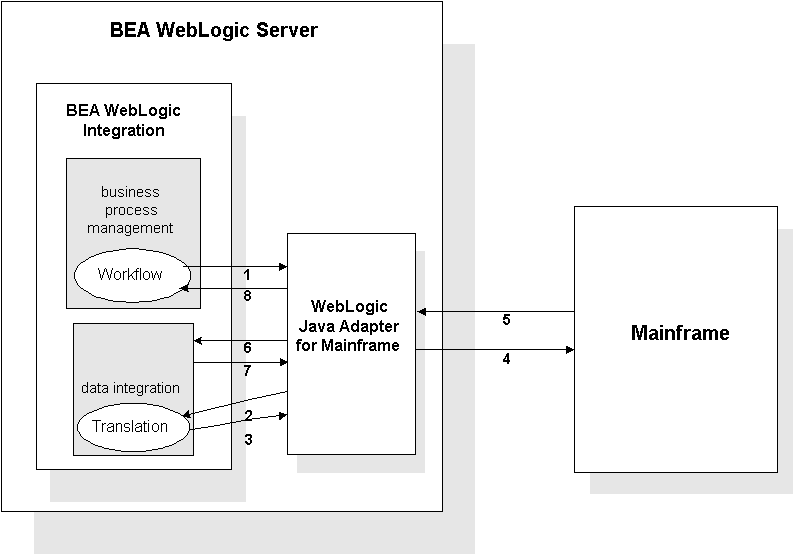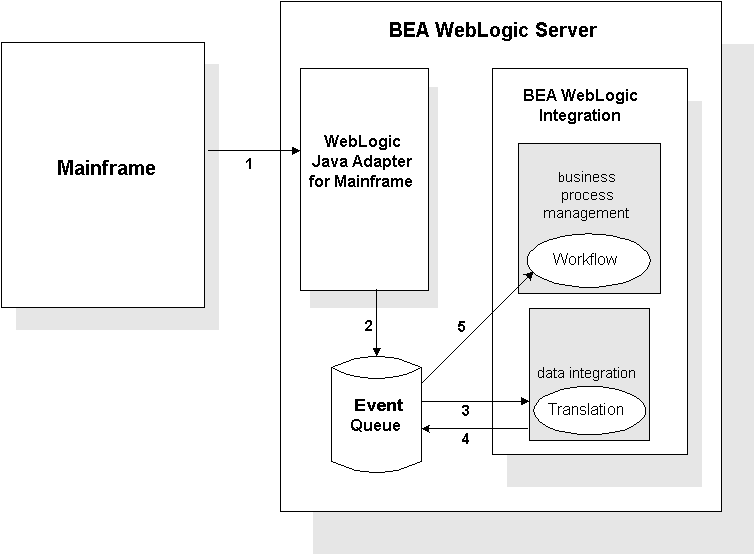


|

|
|
|
|
Workflow Processing with BEA WebLogic Java Adapter for Mainframe
Many customers need an advanced e-business infrastructure that incorporates process rules, workflow, and application components. To meet this need, BEA WebLogic Java Adapter for Mainframe (WebLogic JAM) seamlessly plugs in to BEA WebLogic Integration, a powerful process integration and workflow engine. This software combination allows you to create business processes, process rules, and workflows that access mainframe applications.
WebLogic JAM can be used with WebLogic Integration in the following ways:
This section provides information on the following subjects:
Introduction to Business Process Management with WebLogic Integration
WebLogic Integration provides an intuitive flowchart model for defining business processes that work across the enterprise and in support of business-to-business interactions with minimal human interaction. The powerful workflow engine executes those processes, automatically invoking the resources required at each step. Online process monitoring provides real-time data about how the processes are working and any necessary changes can be made dynamically.
Fully J2EE compliant, WebLogic Integration provides an intuitive graphical user interface that enables businesses to design, monitor, and modify workflow and e-business processes without scripting or programming. Its run-time engine automates and manages the activities of applications and such technologies as fax, WAP-enabled telephones, and other devices, with exception-based human intervention.
WebLogic Integration uses XML as its standard data format. To access data from a legacy system in WebLogic Integration, the data must be converted to XML first. WebLogic Integration provides data integration by allowing you to translate data from binary to XML or from XML to binary.
This section provides information on the following subjects:
Understanding WebLogic Integration Interaction with the Mainframe
Figure1-1 illustrates the flow of data when a WebLogic Integration workflow accesses mainframe applications through WebLogic JAM. When WebLogic Integration sends data to the mainframe application, the WebLogic JAM Gateway converts the XML data received from WebLogic Integration to the binary format expected by the mainframe application. The WebLogic JAM Gateway invokes the data integration component of WebLogic Integration to perform this conversion. It then invokes the mainframe program and receives a response. This response is sent to WebLogic Integration to convert the data from binary format to XML.
Figure 1-1 Workflows Accessing Mainframe Applications
WebLogic JAM also allows a workflow to be initiated by an event triggered by a mainframe application. When WebLogic JAM receives a request from the mainframe, it looks within its configuration to find the destination application within WebLogic Server. If the specified destination is WebLogic Integration, then WebLogic JAM puts the mainframe data on a WebLogic Integration queue. WebLogic Integration pulls the data off the WebLogic Server event queue and recognizes that translation is required. The translation is performed, and the data is returned to the queue. WebLogic Integration workflow that uses this XML is then initiated. This flow of data is illustrated in Figure1-2. Figure 1-2 Mainframe Application Initiating a Workflow
Accessing Mainframe Applications Using WebLogic JAM WebLogic JAM seamlessly plugs in to WebLogic Integration, allowing business analysts to include mainframe applications in business processes. WebLogic JAM uses WebLogic Integration to translate binary data to and from XML. XML is quickly becoming the standard for exchanging information between applications and is invaluable in integrating disparate applications. WebLogic Integration provides for an exchange of information between applications by supporting data translations between binary formats from legacy systems and XML. WebLogic JAM works with WebLogic Integration's data translation feature to convert data between mainframe copybook formats and XML format that can be used by the process engine. 
Roadmap for Workflow Processing with WebLogic JAM
The steps outlined in Figure1-3 provide you with a high-level guideline to all of the tasks and processes that you must perform to install, configure, and work with WebLogic JAM. Think of these steps as a roadmap to guide you through the process and to point you to the resources available to help you.
Figure 1-3 Roadmap for Workflow Processing with WebLogic JAM

|

|

|
|
|
|
Copyright © 2002 BEA Systems, Inc. All rights reserved.
|